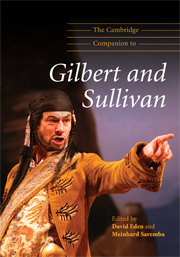Book contents
- Frontmatter
- Part I Background
- Part II Focus
- 5 The operas in context: stylistic elements – the Savoy and beyond
- 6 The librettos in context: Gilbert's ‘fables in song’
- 7 ‘This particularly rapid, unintelligible patter’: patter songs and the word–music relationship
- 8 Standing still and moving forward: The Mikado, Haddon Hall and concepts of time in the Savoy operas
- 9 Musical contexts I: motives and methods in Sullivan's allusions
- 10 Musical contexts II: characterisation and emotion in the Savoy operas
- Part III Reception
- Part IV Into the twenty-first century
- Appendix 1 Who wrote the overtures?
- Appendix 2 Stage and choral works by Arthur Sullivan and W. S. Gilbert
- Appendix 3 Modern editions of works by Arthur Sullivan and W. S. Gilbert
- Appendix 4 Sullivan's archetypes of English opera
- Notes
- Bibliography and further reading
- Index
- Plate section
9 - Musical contexts I: motives and methods in Sullivan's allusions
from Part II - Focus
Published online by Cambridge University Press: 28 September 2011
- Frontmatter
- Part I Background
- Part II Focus
- 5 The operas in context: stylistic elements – the Savoy and beyond
- 6 The librettos in context: Gilbert's ‘fables in song’
- 7 ‘This particularly rapid, unintelligible patter’: patter songs and the word–music relationship
- 8 Standing still and moving forward: The Mikado, Haddon Hall and concepts of time in the Savoy operas
- 9 Musical contexts I: motives and methods in Sullivan's allusions
- 10 Musical contexts II: characterisation and emotion in the Savoy operas
- Part III Reception
- Part IV Into the twenty-first century
- Appendix 1 Who wrote the overtures?
- Appendix 2 Stage and choral works by Arthur Sullivan and W. S. Gilbert
- Appendix 3 Modern editions of works by Arthur Sullivan and W. S. Gilbert
- Appendix 4 Sullivan's archetypes of English opera
- Notes
- Bibliography and further reading
- Index
- Plate section
Summary
The influence of one piece (or style) of music on another is a perplexing issue. The continuum of musical references ranges from the subtlest detail (for example, a similarity in orchestration or a motivic resemblance) to whole-scale appropriation, and examples have been decried or defended as coincidence, plagiarism, incompetence, creative economy, tribute, poetic resonance and brilliant satire. ‘Borrowings’ have long attracted musicological interest; recent studies have turned to more subtle allusions and the meanings behind them. Christopher Reynolds's sophisticated analysis of motivic allusions in nineteenth-century art music explores a complex (and intentional) interrelationship between four parties:
An allusion requires four elements: a composer (author), the new composition, the old composition, and the audience. A composer creates a new work that refers to an existing work (or works) in order to imbue the new work with a meaning that someone will recognize and interpret.
The situation of musical allusions in the comic operas of Gilbert and Sullivan is somewhat more complicated. It is by no means clear that Sullivan's references were always intended to be recognised as such, nor indeed if he was always conscious of the allusions latent in his music. To be sure, there are clear examples of actual quotations which he expected to be recognised and appreciated: the fugue subject from Bach's G minor organ Fantasia (bwv 542) given to clarinet and bassoon as the Mikado sings ‘By Bach, interwoven with Spohr and Beethoven’ is only the most famous such case (‘Amore humane Mikado’, The Mikado, Act II).
- Type
- Chapter
- Information
- The Cambridge Companion to Gilbert and Sullivan , pp. 122 - 135Publisher: Cambridge University PressPrint publication year: 2009
- 1
- Cited by



